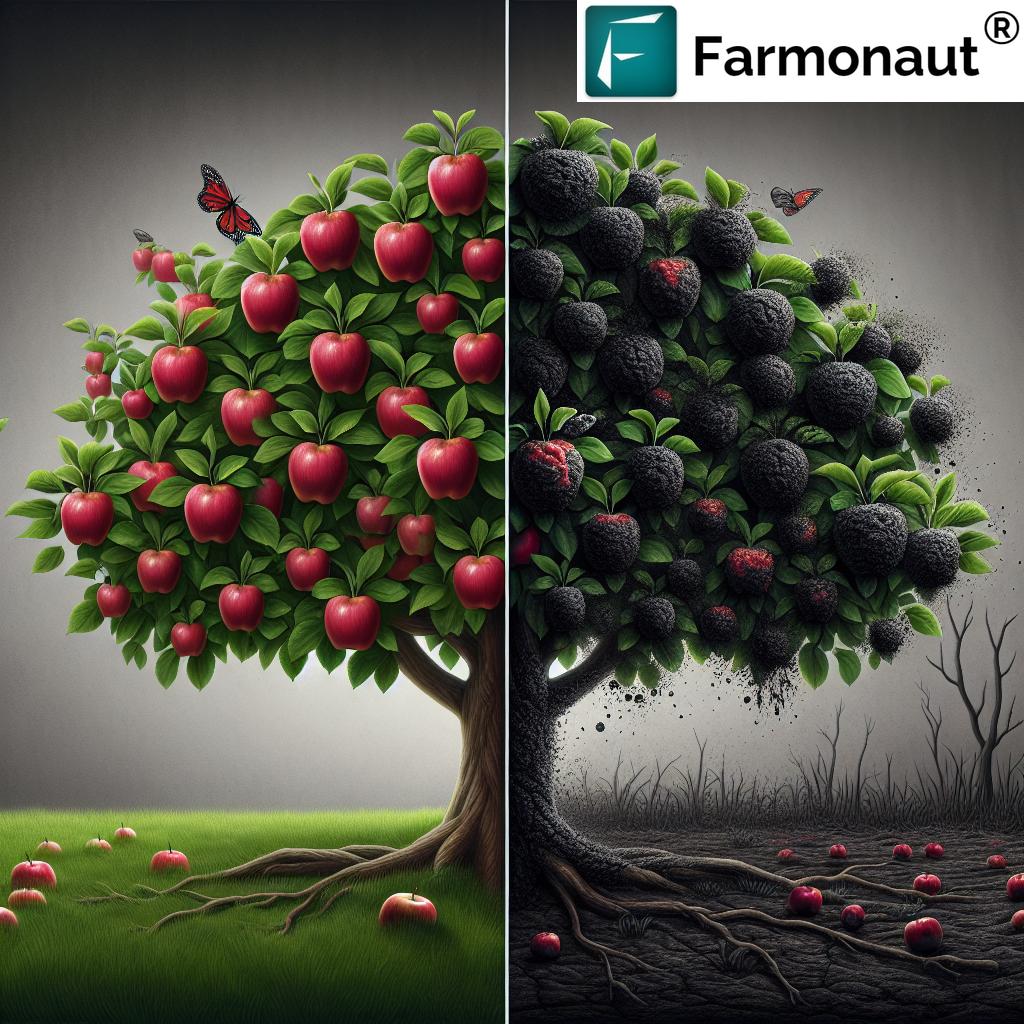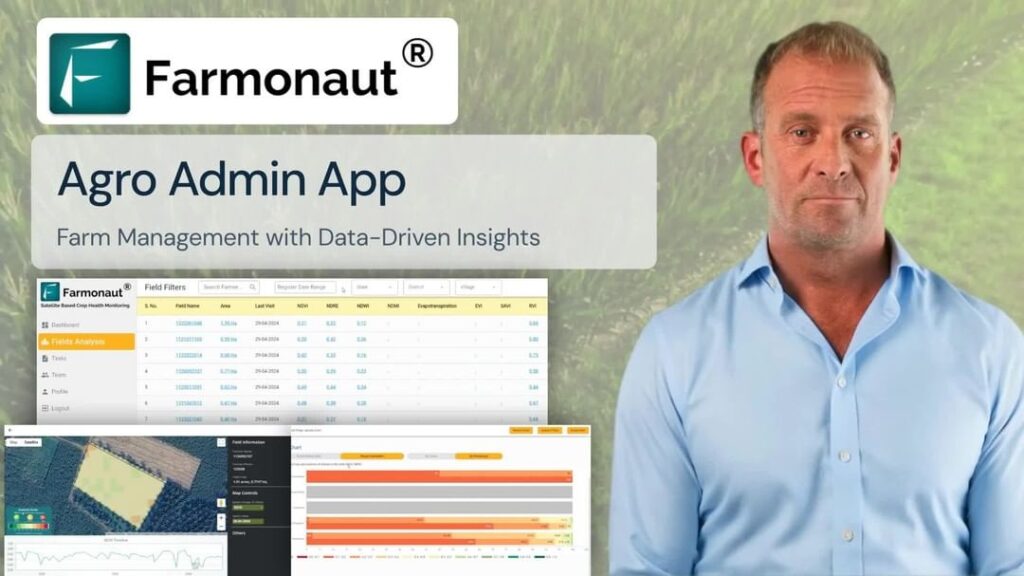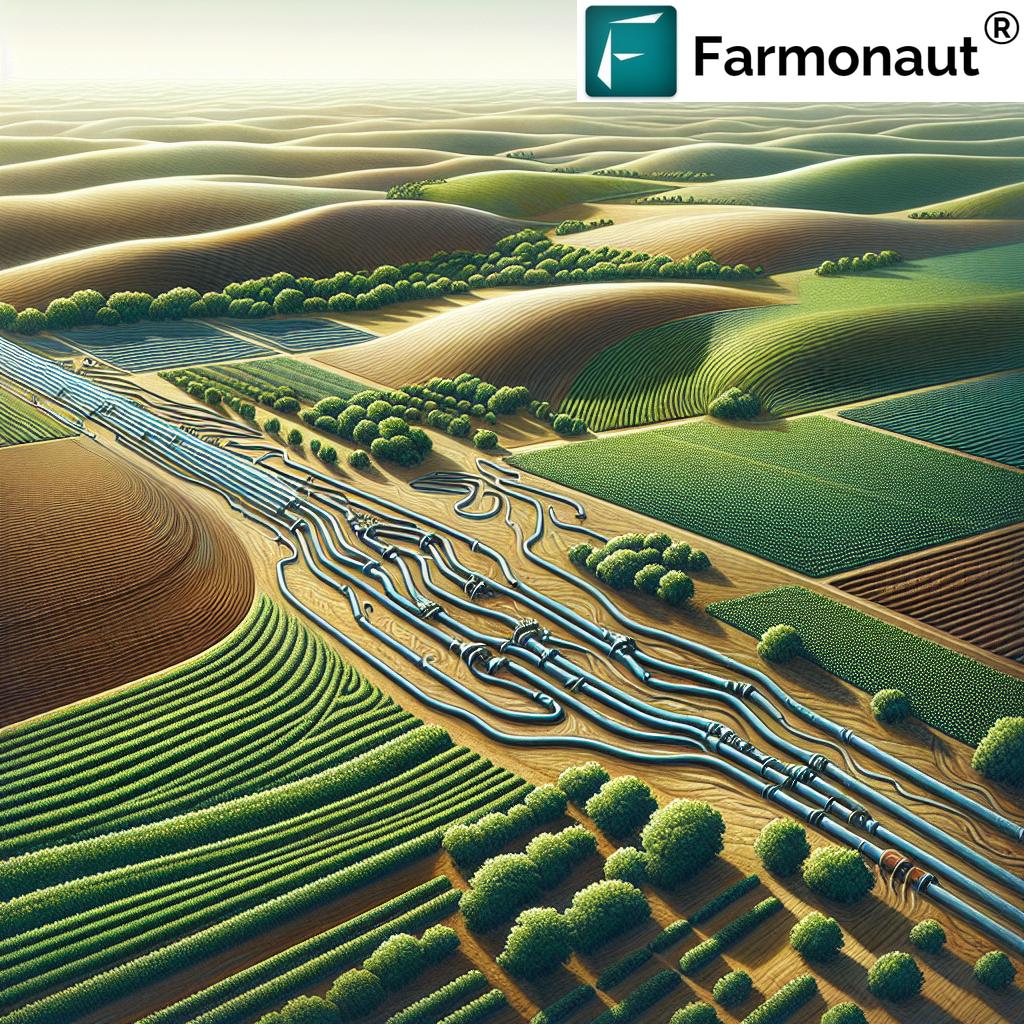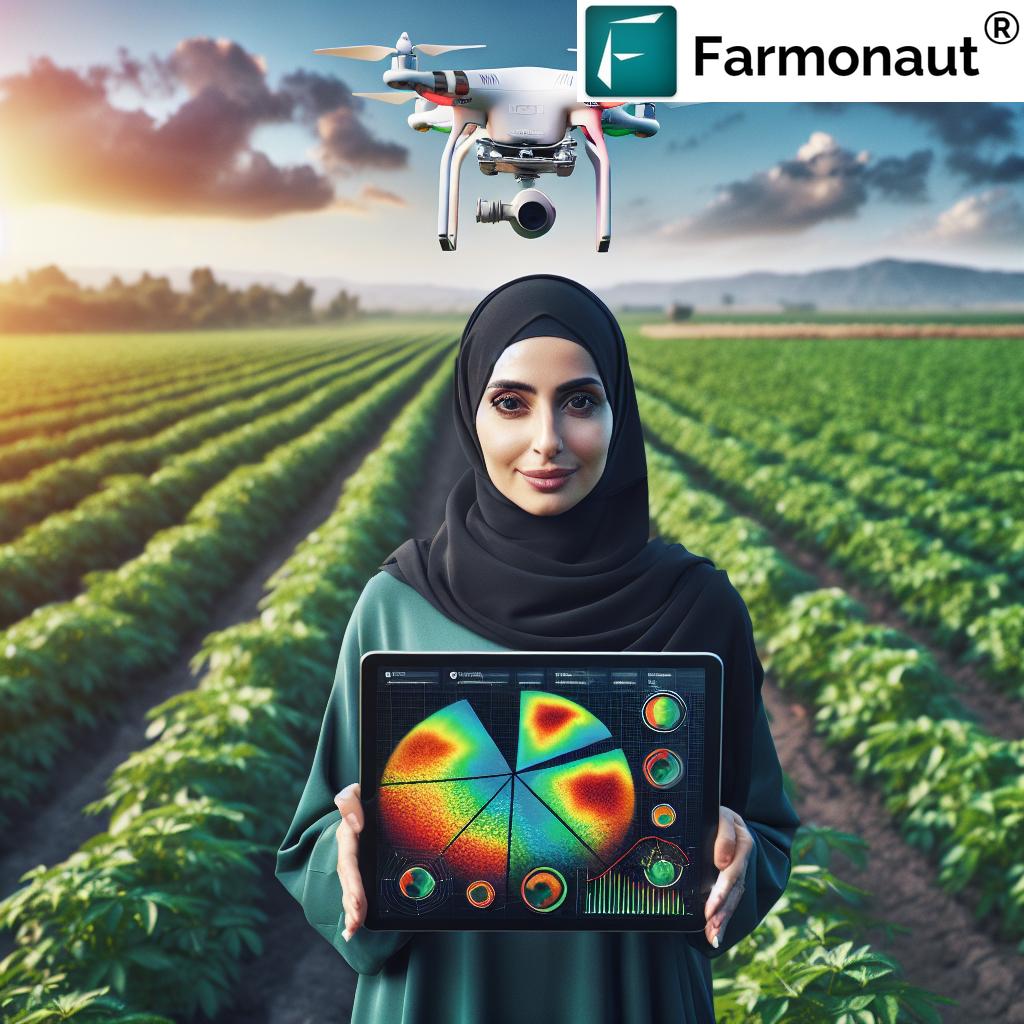Common Crop Diseases and Pests: From Leaf Spot to Fruit Fly – A Comprehensive Guide for Farmers
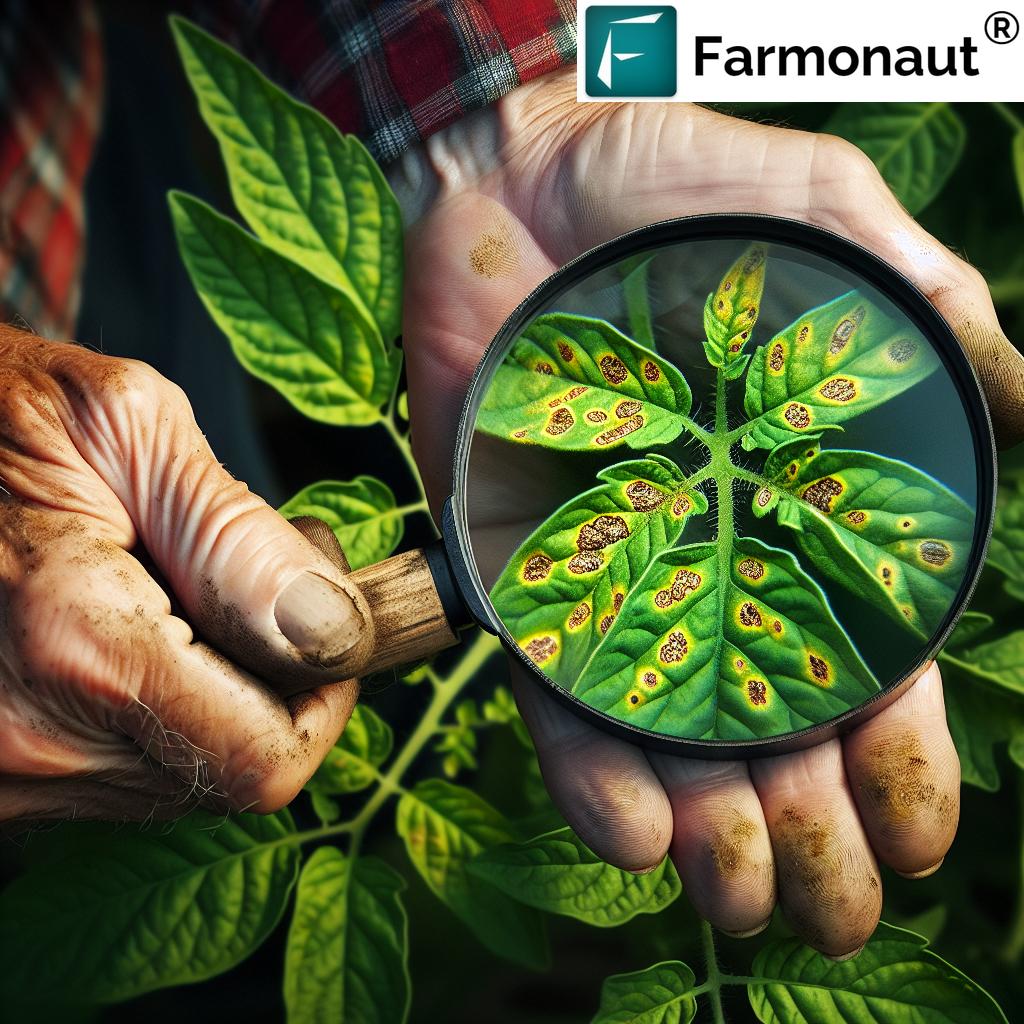
As agricultural experts and representatives of Farmonaut, we understand the critical importance of identifying and managing crop diseases and pests. In this comprehensive guide, we’ll explore a wide range of common issues that farmers face, from leaf spot to fruit fly infestations. Our goal is to provide you with the knowledge and tools necessary to protect your crops and maximize your yields.
The Importance of Early Detection
Early detection of crop diseases and pests is crucial for effective management and prevention of significant yield losses. Traditional scouting methods, while valuable, can be time-consuming and may miss early signs of infestation. At Farmonaut, we’ve developed advanced satellite-based crop monitoring systems that can revolutionize how farmers detect and respond to these threats.
| Feature | Traditional Scouting | Farmonaut’s Satellite-Based Monitoring |
|---|---|---|
| Detection Speed | Slow (manual inspection required) | Fast (real-time satellite imagery analysis) |
| Accuracy | Varies (dependent on scout’s expertise) | High (AI-powered analysis) |
| Coverage Area | Limited (time-consuming for large areas) | Extensive (entire fields monitored simultaneously) |
| Cost-effectiveness | Low (labor-intensive) | High (automated and scalable) |
| Early Detection of Leaf Spot | Challenging (may miss early stages) | Efficient (detects subtle changes in vegetation health) |
| Powdery Mildew Identification | Requires close inspection | Can detect early signs through spectral analysis |
As you can see, our satellite-based monitoring system offers significant advantages in speed, accuracy, and coverage. To learn more about how Farmonaut can help protect your crops, visit our app.
Common Crop Diseases
1. Leaf Spot Diseases
Leaf spot diseases are among the most common issues faced by farmers across various crops. These diseases are characterized by discolored spots on leaves, which can lead to defoliation and reduced crop yields if left untreated.
- Symptoms: Circular or irregular spots on leaves, often with a yellow halo
- Affected Crops: Tomatoes, peppers, cucurbits, and many others
- Management: Proper spacing, crop rotation, and fungicide application when necessary
2. Powdery Mildew
Powdery mildew is a fungal disease that affects a wide range of crops, particularly in warm, humid conditions.
- Symptoms: White, powdery coating on leaves, stems, and sometimes fruit
- Affected Crops: Grapes, cucurbits, apples, and many ornamental plants
- Management: Improve air circulation, use resistant varieties, and apply fungicides when needed
3. Mosaic Viruses
Mosaic viruses are a group of plant viruses that cause mottled and distorted leaves, stunted growth, and reduced yields.
- Symptoms: Mottled leaf coloration, leaf distortion, and stunted growth
- Affected Crops: Tomatoes, cucurbits, beans, and many others
- Management: Use virus-resistant varieties, control insect vectors, and practice good sanitation
4. Blight Diseases
Blight diseases, such as early blight and late blight, can cause rapid and severe damage to crops.
- Symptoms: Dark lesions on leaves, stems, and fruit; rapid wilting and tissue death
- Affected Crops: Potatoes, tomatoes, and other solanaceous crops
- Management: Use resistant varieties, practice crop rotation, and apply fungicides preventatively
5. Bacterial Diseases
Bacterial diseases can affect various parts of the plant and are often challenging to control.
- Symptoms: Water-soaked lesions, cankers, wilting, and fruit rot
- Affected Crops: Wide range, including tomatoes, peppers, and fruit trees
- Management: Practice good sanitation, use disease-free seeds, and apply copper-based bactericides
Common Crop Pests
1. Aphids
Aphids are small, soft-bodied insects that feed on plant sap and can transmit viruses.
- Symptoms: Curled or distorted leaves, sticky honeydew on leaves
- Affected Crops: Wide range, including vegetables, fruits, and ornamentals
- Management: Encourage natural predators, use insecticidal soaps, and apply systemic insecticides if necessary
2. Scale Insects
Scale insects are small, immobile pests that attach themselves to plant tissues and feed on sap.
- Symptoms: Small, waxy or shell-like bumps on stems and leaves; yellowing leaves
- Affected Crops: Fruit trees, ornamental plants, and some vegetables
- Management: Prune affected areas, use horticultural oils, and apply insecticides when infestation is severe
3. Fruit Flies
Fruit flies are small flying insects that lay eggs in ripening fruit, causing significant damage to crops.
- Symptoms: Small punctures in fruit, premature fruit drop, maggots in fruit
- Affected Crops: Various fruits, including citrus, stone fruits, and berries
- Management: Use pheromone traps, practice good sanitation, and apply targeted insecticides
4. Mites
Mites are tiny arachnids that can cause significant damage to crops, particularly in hot, dry conditions.
- Symptoms: Stippling on leaves, webbing on plants, bronzing of leaves
- Affected Crops: Wide range, including vegetables, fruits, and ornamentals
- Management: Maintain proper irrigation, use predatory mites, and apply miticides when necessary
5. Caterpillars and Moths
Various caterpillars and moths, such as the codling moth, can cause significant damage to crops.
- Symptoms: Chewed leaves, holes in fruit, presence of frass (excrement)
- Affected Crops: Wide range, including fruits, vegetables, and field crops
- Management: Use pheromone traps, encourage natural predators, and apply targeted insecticides
Crop-Specific Diseases and Pests
Citrus Diseases
Citrus canker and citrus greening are two devastating diseases affecting citrus crops worldwide.
- Citrus Canker:
- Symptoms: Raised, corky lesions on leaves, stems, and fruit
- Management: Remove infected trees, use windbreaks, and apply copper-based bactericides
- Citrus Greening:
- Symptoms: Mottled leaves, stunted growth, and misshapen, bitter fruit
- Management: Control insect vectors, remove infected trees, and use disease-free planting material
Grape Diseases
Downy mildew and botrytis cinerea (gray mold) are common issues in grape cultivation.
- Downy Mildew:
- Symptoms: Yellow spots on upper leaf surfaces, white fuzzy growth on lower surfaces
- Management: Improve air circulation, apply fungicides preventatively
- Botrytis Cinerea:
- Symptoms: Gray, fuzzy mold on grapes and other plant parts
- Management: Canopy management, timely harvest, and fungicide application
Palm Diseases
Lethal yellowing and fusarium wilt are serious threats to palm trees.
- Lethal Yellowing:
- Symptoms: Yellowing fronds, premature fruit drop, and eventual tree death
- Management: Use resistant varieties, remove infected trees, and control insect vectors
- Fusarium Wilt:
- Symptoms: One-sided leaf wilt, internal stem discoloration
- Management: Use resistant varieties, practice good sanitation, and avoid wounding trees
Tomato Diseases
Tomato yellow leaf curl virus and bacterial wilt are significant challenges for tomato growers.
- Tomato Yellow Leaf Curl Virus:
- Symptoms: Yellowing and curling of leaves, stunted growth
- Management: Use resistant varieties, control whitefly vectors, and use reflective mulches
- Bacterial Wilt:
- Symptoms: Rapid wilting of plants, brown discoloration of vascular tissue
- Management: Crop rotation, use of grafted plants, and soil solarization
Apple Diseases
Apple scab and fire blight are common issues in apple orchards.
- Apple Scab:
- Symptoms: Olive-green to black spots on leaves and fruit
- Management: Use resistant varieties, apply fungicides, and practice good orchard sanitation
- Fire Blight:
- Symptoms: Blackened, wilted shoots forming a “shepherd’s crook”
- Management: Prune infected branches, use copper-based sprays, and avoid excessive nitrogen fertilization
Banana Diseases
Black Sigatoka and Panama disease pose significant threats to banana production.
- Black Sigatoka:
- Symptoms: Black streaks on leaves, eventually leading to leaf necrosis
- Management: Use resistant varieties, apply fungicides, and practice good leaf management
- Panama Disease:
- Symptoms: Yellowing and wilting of leaves, internal stem discoloration
- Management: Use resistant varieties, practice quarantine measures, and avoid spreading infected soil
Nutrient Deficiencies and Disorders
In addition to diseases and pests, nutrient deficiencies and physiological disorders can also affect crop health and yield. Here are some common issues:
1. Nutrient Deficiencies
- Nitrogen Deficiency: Yellowing of older leaves, stunted growth
- Phosphorus Deficiency: Purple discoloration of leaves, reduced fruit set
- Potassium Deficiency: Marginal leaf scorch, weak stems
- Magnesium Deficiency: Interveinal chlorosis, particularly in older leaves
- Iron Deficiency: Interveinal chlorosis, particularly in young leaves
2. Physiological Disorders
- Blossom End Rot: Dark, sunken lesions at the blossom end of fruits, particularly in tomatoes and peppers
- Fruit Cracking: Splitting or cracking of fruit due to irregular watering or rapid growth
- Sunscald: Whitish, papery patches on fruits exposed to intense sunlight
- Leaf Curl: Curling or twisting of leaves due to environmental stress or viral infections
Integrated Pest Management (IPM) Strategies
At Farmonaut, we advocate for an Integrated Pest Management (IPM) approach to crop protection. This strategy combines various control methods to manage pests and diseases effectively while minimizing environmental impact and promoting sustainable agriculture.
Key Components of IPM:
- Prevention: Use resistant varieties, practice crop rotation, and maintain proper field sanitation
- Monitoring: Regularly scout fields and use advanced technologies like our satellite-based monitoring system
- Cultural Control: Adjust planting dates, improve irrigation practices, and manage crop residues
- Biological Control: Encourage natural predators and use biopesticides
- Chemical Control: Use pesticides judiciously and only when necessary
Our satellite-based monitoring system plays a crucial role in the monitoring aspect of IPM. By providing real-time data on crop health, we enable farmers to detect issues early and take targeted action, reducing the need for broad-spectrum pesticide applications.
The Role of Technology in Crop Protection
At Farmonaut, we’re at the forefront of integrating technology into crop protection strategies. Our advanced satellite-based monitoring system offers several advantages:
- Early Detection: Our system can identify subtle changes in crop health before they’re visible to the naked eye, allowing for early intervention
- Large-Scale Monitoring: We can monitor vast areas quickly and efficiently, providing a comprehensive view of crop health across entire fields or regions
- Data-Driven Decision Making: Our AI-powered analysis provides actionable insights, helping farmers make informed decisions about pest and disease management
- Resource Optimization: By identifying specific problem areas, our system helps farmers target their interventions, reducing unnecessary pesticide use and saving resources
To learn more about how our technology can help protect your crops, visit our app page or explore our API documentation.
Best Practices for Crop Protection
While technology plays a crucial role in modern agriculture, implementing good farming practices remains essential for effective crop protection. Here are some best practices we recommend:
- Crop Rotation: Rotate crops to break pest and disease cycles
- Sanitation: Remove crop debris and infected plants to reduce disease inoculum
- Proper Irrigation: Avoid overwatering and use drip irrigation when possible to reduce leaf wetness
- Nutrient Management: Maintain proper soil fertility to promote plant health and resistance to pests and diseases
- Timely Planting and Harvesting: Adjust planting and harvesting dates to avoid peak pest pressures
- Regular Monitoring: Scout fields regularly and use our satellite-based monitoring for comprehensive coverage
- Integrated Pest Management: Implement a holistic approach to pest and disease control
- Record Keeping: Maintain detailed records of pest occurrences, treatments, and outcomes to inform future decisions
The Future of Crop Protection
As we look to the future, several emerging trends and technologies are shaping the field of crop protection:
- Precision Agriculture: Increasing use of data-driven, site-specific management strategies
- Artificial Intelligence: Advanced AI algorithms for early detection and diagnosis of crop issues
- Drone Technology: Use of drones for targeted pesticide application and close-up crop monitoring
- Biopesticides: Development of more effective and environmentally friendly biological control agents
- Gene Editing: Creation of pest-resistant crop varieties through advanced genetic techniques
- IoT in Agriculture: Integration of sensors and connected devices for real-time monitoring and automation
At Farmonaut, we’re continually innovating to stay at the forefront of these developments. Our goal is to provide farmers with the most advanced tools and insights to protect their crops effectively and sustainably.
Conclusion
Protecting crops from diseases, pests, and disorders is a complex but essential task for ensuring food security and agricultural sustainability. By combining traditional farming wisdom with cutting-edge technology, we can develop more effective and environmentally friendly crop protection strategies.
At Farmonaut, we’re committed to empowering farmers with the tools and knowledge they need to succeed in this challenging field. Our satellite-based monitoring system, combined with our expertise in agricultural science, provides a powerful solution for early detection and management of crop issues.
We invite you to explore our services and see how we can help you protect your crops and improve your yields. Visit our app page to get started, or check out our API documentation for integration options.
FAQs
- Q: How does Farmonaut’s satellite-based monitoring detect crop diseases?
A: Our system analyzes multispectral satellite imagery to detect subtle changes in plant health, often identifying issues before they’re visible to the naked eye. - Q: Can Farmonaut’s system distinguish between different types of crop issues?
A: While our system can detect changes in crop health, specific diagnosis often requires additional on-ground verification. However, our AI algorithms are continuously improving in their ability to differentiate between various issues. - Q: How often is the satellite data updated?
A: The frequency of updates depends on the specific service package. Generally, we provide updates every 3-5 days, weather permitting. - Q: Is Farmonaut’s system suitable for small-scale farmers?
A: Yes, we offer solutions tailored to farms of all sizes. Our goal is to make precision agriculture accessible to all farmers. - Q: How can I integrate Farmonaut’s data into my existing farm management system?
A: We offer API access that allows for seamless integration with many farm management systems. Check our API documentation for more details.
Ready to take your crop protection to the next level? Subscribe to Farmonaut today:
